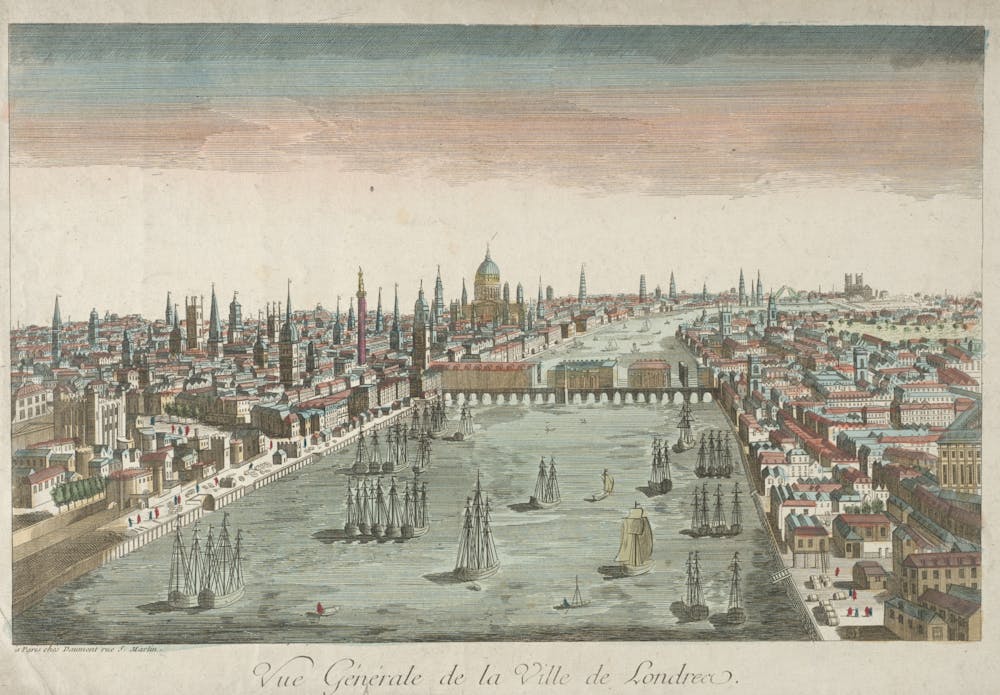On Thursday, March 7, the Virginia Fox Stern Center for the Study of the Book in the Renaissance, situated at Hopkins Sheridan Libraries, hosted Olivia Weisser, professor at the University of Massachusetts Boston and a historian of medicine. Weisser’s research focuses on health in 16th- to 18th-century Britain, and her lecture titled “Shopping for Pox Cures in Early Modern London” analyzed the process of purchasing treatments for venereal disease, a term that encompasses what are today known as sexually transmitted diseases.
Weisser opened by discussing her use of print sources, such as print advertisements from healers, to trace the locations where cures for venereal disease could be purchased. Due to London’s rapid economic and population growth during the late 1600s to mid-1700s, venereal disease was rampant. By using addresses from these print advertisements and trade cards, Weisser was able to create a map of places in London that sold cures.
The term “pox” refers to the sexually transmitted disease syphilis. In Wiesser’s map, she plotted out around 230 places where people could purchase pox cures in the span of a century. She was able to conclude that pox cures were not limited to one specific area in London and could be readily found, especially in commercial areas where people shopped.
“Pox cures were uniformly spread throughout the city – there was not a lot of clustering,” Weisser said. “And, typically in this time period, you would find the same products for sale in particular spots because of guilds or because of the economic principle that product clustering sells. Not so with pox cures. You could find them just about anywhere.”
London became paramount in studying the history of venereal disease due to the city’s dynamic and competitive commercial market for these cures.
“[London’s] population more than doubled over the course of the 1600s. There was a steady migration of people and trade networks that created a dense urban population. And this size, growth and mobility of London’s population made conspicuous consumption possible,” Weisser explained.
Venereal disease often visibly marred individuals, creating a stigma around the illness. Due to the high demand for treatment in London, Weisser explained how many healers began to develop quick and discrete drugs. Among these treatments was mercury, which was believed to mitigate the symptoms of venereal disease.
Weisser continued to explain that people in the 17th and 18th centuries would often purchase cures for venereal disease in non-medical spaces. Printers and booksellers were the primary locations where individuals could purchase these pox cures. Cures could also be found in taverns, coffee shops and even cheese shops. Often, uncredentialed healers marketed their treatments to customers by using the same language of medical professionals. Since venereal disease was heavily stigmatized, individuals would shop for these cures with as much discretion as possible.
“There was an uptick in consumerism, an influx of new ingredients [and] a mostly unregulated market of healers and a hugely prevalent disfiguring disease,” Weisser said. “All of this together created a vast trade in pox cures and a lot of uncredentialed practitioners stepped in to meet a soaring demand. There were a lot of ready-made drugs that were promised to be quick, tasty and private. In effect, these drugs removed healers from commercial transactions.”
Mapping out the market for pox cures led Weisser to comb through archival records and English print sources, which is why her lecture offered a segue for Mary Fissell, Inaugural J. Mario Molina Professor of the History of Medicine at Hopkins, to introduce the Reading Early Medicine (REM) project. REM originated at the Max Planck Institute for the History of Science in Berlin and was later transferred to the Hopkins Sheridan Libraries.
REM is a database of around 3,000 English language medical sources. Fissell explained how the site contained medical print sources dating from the 15th century up to the 1700s. The REM project’s goal is to present these academic resources in a more digestible way for undergraduate students as well as professors and researchers.
In her interview with The News-Letter, Weisser talked about the importance of looking back at the history of medicine.
“Studying the past gives us the tools to think about the assumptions we might bring to the table as a clinician – about maybe a person’s race or class or gender presentation – in ways that we wouldn’t be able to do otherwise. It gives us a more holistic understanding of how we got here. Clinicians who have a historical grounding can understand that getting to where we are today is not a foregone conclusion,” she concluded.





